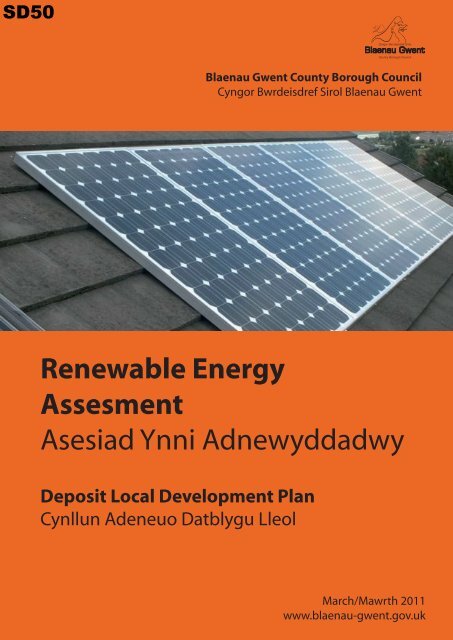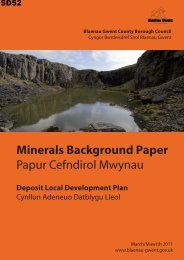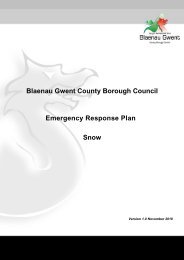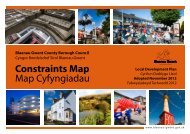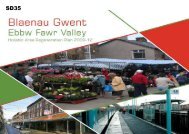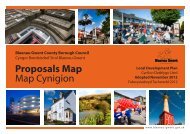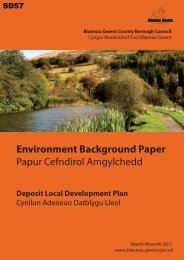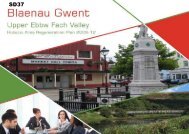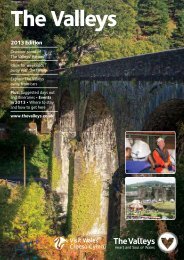renewable energy assessment - Blaenau Gwent County Borough ...
renewable energy assessment - Blaenau Gwent County Borough ...
renewable energy assessment - Blaenau Gwent County Borough ...
- No tags were found...
You also want an ePaper? Increase the reach of your titles
YUMPU automatically turns print PDFs into web optimized ePapers that Google loves.
<strong>Blaenau</strong> <strong>Gwent</strong> <strong>County</strong> <strong>Borough</strong> CouncilCyngor Bwrdeisdref Sirol <strong>Blaenau</strong> <strong>Gwent</strong>Renewable EnergyAssesmentAsesiad Ynni AdnewyddadwyDeposit Local Development PlanCynllun Adeneuo Datblygu LleolMarch/Mawrth 2011www.blaenau-gwent.gov.uk
RENEWABLE ENERGY ASSESSMENTThe text of this document draws largely on the Pilot Study –Pembrokeshire <strong>County</strong> Council Renewable Energy Assessment, July2010, which was produced by AECOM for the Welsh AssemblyGovernment as part of the Planning for Renewable and Low CarbonEnergy – A Toolkit for Planners.The contribution is acknowledged; however all evidence, data sourcesand target information is relevant to <strong>Blaenau</strong> <strong>Gwent</strong> <strong>County</strong> <strong>Borough</strong>Council and has been produced by <strong>Blaenau</strong> <strong>Gwent</strong> <strong>County</strong> <strong>Borough</strong>Council in this regard to inform the <strong>Blaenau</strong> <strong>Gwent</strong> Local DevelopmentPlan
RENEWABLE ENERGY ASSESSMENT
CONTENTSRENEWABLE ENERGY ASSESSMENTPageEXECUTIVE SUMMARY 11.0 INTRODUCTIONBackground and Purpose of the Renewable Energy AssessmentPlanning PolicyWider Corporate RoleScope of the Renewable Energy AssessmentDefining Renewable Energy and Low Carbon EnergyExplanation of Energy Terms2.0 POLICY CONTEXT AND DRIVERS FOR RENEWABLEENERGYIntroductionUK and European Policy ContextWales Policy Context for Planning and Renewable EnergyWales Wider Policy ContextOther UK Drivers for Renewable EnergyWelsh Assembly Government’s Community Scale Renewable EnergyProgrammeWood Energy Business Scheme (WEBS)3.0 HOW TO USE THIS RENEWABLE ENERGY ASSESSMENTStructure of the Renewable Energy AssessmentWho has Developed this REA?4.0 BLAENAU GWENT COUNTY BOROUGH AREA WIDERENEWABLE ENERGY ASSESSMENTCalculating Existing and Future Energy BaselineExisting and Proposed Low Zero Carbon Energy TechnologiesWind Energy ResourceBiomass <strong>energy</strong> resourceEnergy from wasteAnaerobic DigestionHydropower Energy Resource5.0 BUILDINGS INTEGRATED RENEWABLE UPTAKEASSESSMENTIntroduction to BIRModelling BIR – Overview6.0 ASSESSMENT SUMMARYResource Summary Tables334445799991011121214141415151618202223252626273131APPENDICESAppendix 1:Wind Energy Resource Constraints MapAppendix 2: Potential Wind Energy Clusters (Upper Bound Figure)Appendix 3: Potential Wind Energy Clusters (Lower Bound Figure)
Appendix 4: Potential ‘Win-Win’ LocationsRENEWABLE ENERGY ASSESSMENTTABLESTable 1: Renewable Energy Technologies covered by the REATable 2: Total DECC Energy 2008 (GWh) data reported by UK RESEnergy Sector for <strong>Blaenau</strong> <strong>Gwent</strong>Table 3: Predicted Future Energy Demand for <strong>Blaenau</strong> <strong>Gwent</strong>Table 4: Existing Renewable Electricity Capacity in <strong>Blaenau</strong> <strong>Gwent</strong>Table 5: Existing Renewable Heat Capacity in <strong>Blaenau</strong> <strong>Gwent</strong>Table 6: Wind Resource PriorityTable 7: Unconstrained Wind Resource Output for <strong>Blaenau</strong> <strong>Gwent</strong>Table 8: Potential Accessible Wind Resource across <strong>Blaenau</strong> <strong>Gwent</strong>(Upper Bound Figure)Table 9: Potential Accessible Wind Resource across <strong>Blaenau</strong> <strong>Gwent</strong>(Lower Bound Figure)Table 10: Recalculation of the Upper and Lower Bound AccessibleWind Energy ResourceTable 11:Potential Available Biomass Resource for <strong>Blaenau</strong> <strong>Gwent</strong>Table 12: Potential Energy from Waste Resource for <strong>Blaenau</strong> <strong>Gwent</strong>Table 13: Potential Energy from Food Waste in <strong>Blaenau</strong> <strong>Gwent</strong>Table 14: Potential Installed Capacity from Total Available AnimalManure in <strong>Blaenau</strong> <strong>Gwent</strong>Table 15: Potential Energy from Sewage Sludge in <strong>Blaenau</strong> <strong>Gwent</strong>Table 16: Potential Energy from Hydropower in <strong>Blaenau</strong> <strong>Gwent</strong>Table 17: Potential Energy from BIR Renewable Electricity Sources in<strong>Blaenau</strong> <strong>Gwent</strong>Table 18: Data used for Future Non-Residential Development from BIRElectricity SourcesTable 19: Potential Energy from BIR Renewable Heat Sources in<strong>Blaenau</strong> <strong>Gwent</strong>Table 20: Data used for Future Non-Residential Development from BIRHeat SourcesTable 21: Resource Summary for Potential Renewable Electricity in<strong>Blaenau</strong> <strong>Gwent</strong>Table 22: Resource Summary for Potential Renewable Heat in<strong>Blaenau</strong> <strong>Gwent</strong>Table 23: <strong>Blaenau</strong> <strong>Gwent</strong> Energy Potential and UK Preferred Scenario616161717191920202021232324242527292930313232
RENEWABLE ENERGY ASSESSMENTEXECUTIVE SUMMARYThe One Wales document sets out the Welsh Assembly Government’s commitmentto tackling climate change which include achieving annual carbon reductionequivalentemissions reductions of 3% per year by 2011 in areas of devolvedcompetence. The Assembly Government resolves that all will play the fullest part inreducing CO 2 emissions and is committed to developing a comprehensive <strong>energy</strong>strategy and a <strong>renewable</strong> <strong>energy</strong> route map to ensure understanding of what“playing full part” will mean.Considerable responsibility for delivery of a low carbon <strong>Blaenau</strong> <strong>Gwent</strong> <strong>County</strong><strong>Borough</strong> Council rests with the various departments within the <strong>County</strong> <strong>Borough</strong>Council, with key roles in planning, waste management, and technical services.Acknowledging this responsibility, a county borough wide Renewable EnergyAssessment (REA) has been prepared to assess the potential of the <strong>Blaenau</strong> <strong>Gwent</strong>area to contribute to national greenhouse gas emission reduction targets.<strong>Blaenau</strong> <strong>Gwent</strong> <strong>County</strong> <strong>Borough</strong> Council is currently preparing its LocalDevelopment Plan. Changes to legislation require all local planning authorities toproduce REAs as part of their wider evidence base in support of LDPs.Renewable Energy Assessments will vary between local authorities dependentupon issues such as geography, land availability and also the priorities given bycouncils and communities to various policy objectives. This REA provides theresults of a robust exercise, following the Welsh Assembly Government’sRenewable Energy Assessment Toolkit for Planners, to establish the potential for<strong>renewable</strong> <strong>energy</strong> in the <strong>County</strong> <strong>Borough</strong> that could support a selection of policyobjectives: many of which could also be addressed through corporate action.The methodology used in this report follows the step-by-step guide contained in the‘toolkit’ and calculates the potential <strong>renewable</strong> <strong>energy</strong> resource from the followingsources: wind, wood fuel and <strong>energy</strong> crops (biomass); <strong>energy</strong> from waste;anaerobic digestion – (animal manure, food waste, poultry litter and sewagesludge); and hydropower. It also estimates Buildings Integrated Renewable (BIR)uptake.It is noted that for <strong>Blaenau</strong> <strong>Gwent</strong>, the percentage of <strong>renewable</strong> electricitygeneration exceeds the UK-wide target. However, heat demand potentially met by<strong>renewable</strong> <strong>energy</strong> sources is below the 12% target. LDP policies could therefore beformulated to encourage more of the <strong>County</strong> <strong>Borough</strong>’s electricity and heatrequirements to be generated by <strong>renewable</strong> and low/zero carbon technologies onfuture development sites. This will need to be balanced against the cost ofimplementing such schemes and the impact on development viability this will bring.Delivering some of the potential identified in this REA is likely to requireconsiderable co-operation between the Council and other public sector bodies, andbetween public and private sector. The greatest challenge to this co-operation mayarise in attempting to reduce the carbon emissions of existing building stock,potentially through linking to Heat Networks or larger scale <strong>renewable</strong> electricitygenerating technologies.1
RENEWABLE ENERGY ASSESSMENTThe public sector, tasked with a leadership role, should be pro-active in identifyingcost effective approaches to contributing to meeting targets and facilitating thesuccess of others. <strong>Blaenau</strong> <strong>Gwent</strong> <strong>County</strong> <strong>Borough</strong> Council, through this REA, isfulfilling this role in identifying some of these potential opportunities within its area.2
RENEWABLE ENERGY ASSESSMENT1.0 INTRODUCTIONBackground and Purpose of the Renewable Energy Assessment1.1 The Welsh Assembly Government, through its Climate Change Strategy hasresolved that all will play the fullest possible part in meeting statutory UK and EUtargets on greenhouse gas emission reduction.1.2 Climate change and <strong>energy</strong> security are key priorities of both the UK and WelshAssembly Governments. The use of fossil fuels is seen as a major contributor togreenhouse gas emissions, a major cause of global climate change and movingtowards a low carbon <strong>energy</strong> based economy to tackle the causes of climatechange and improve <strong>energy</strong> security are a Government priority. The generation anduse of <strong>renewable</strong> and low carbon <strong>energy</strong> sources has a key role to play in this andthe UK Government is committed to meeting the EU target of 15% of <strong>energy</strong> from<strong>renewable</strong> sources by 2020. Modelling undertaken by the UK Department forEnergy and Climate Change (DECC) suggests that by 2020, this could mean:• More than 30% electricity generated to come from <strong>renewable</strong> sources;• 12% of our heat generated from <strong>renewable</strong> <strong>energy</strong> sources; and• 10% transport <strong>energy</strong> from <strong>renewable</strong> <strong>energy</strong> sources.1.3 The Climate Change Act 2008 introduces a legally binding target of at least a 34%cut in greenhouse gas emissions by 2020, and at least an 80% cut by 2050, againsta 1990 baseline.1.4 In terms of the land use planning system the Assembly Government has producedpolicy guidance in Planning Policy Wales and the associated Technical Advice Note(TAN) 8 on <strong>renewable</strong> <strong>energy</strong>. In its ‘One Wales’ commitments the AssemblyGovernment has stated that “following the production of the Energy Route Map andan Energy Strategy, it will review TAN 8, revising upwards the targets from<strong>renewable</strong> <strong>energy</strong>, drawn from a variety of sources”.1.5 Local Authorities have several key roles to play that can facilitate the use andgeneration of <strong>renewable</strong> and low carbon <strong>energy</strong>. These include:1. Developing Planning – preparing planning policies and allocating land in theirLocal Development Plans (LDPs)2. Development management – taking decisions on planning applicationssubmitted to the local planning authority for development; as well as preparingLocal Impact Assessments for schemes which are determined by theInfrastructure Planning Commission3. Corporate – taking action at a council wide level to achieve a low carboneconomy4. Leadership – taking forward wider community action and communicating theneed to increase the uptake of <strong>renewable</strong> <strong>energy</strong>1.6 This REA has been prepared by <strong>Blaenau</strong> <strong>Gwent</strong> <strong>County</strong> <strong>Borough</strong> to inform the firstof these. This REA constitutes an evidence base to underpin LDP policies that cansupport and facilitate the deployment of <strong>renewable</strong> and low carbon <strong>energy</strong> systems.3
RENEWABLE ENERGY ASSESSMENT1.7 The REA consists of an <strong>assessment</strong> of the potential for <strong>renewable</strong> and lowcarbon <strong>energy</strong> generation at the <strong>County</strong> <strong>Borough</strong> scale. It does not assess thepotential for generation for individual sites.1.8 In terms of development management, this REA in the case of wind developmentscan assist officers in understanding why a developer has chosen a particularlocation to develop a scheme.1.9 However, as well as supporting the Council with the LDP, the intention is that the<strong>renewable</strong> <strong>energy</strong> opportunities identified will also be useful in assisting localauthorities to fulfil the third and fourth roles identified above.Planning Policy1.10 This REA can assist <strong>Blaenau</strong> <strong>Gwent</strong> <strong>County</strong> <strong>Borough</strong> to deliver national planningpolicy expectations as set out in Planning Policy Wales, namely the requirementthat “local planning authorities (LPA’s) should undertake an <strong>assessment</strong> of thepotential for all <strong>renewable</strong> <strong>energy</strong> resources, <strong>renewable</strong> <strong>energy</strong> technologies,<strong>energy</strong> efficiency and conservation measures, and to include appropriate policies inLDP’s”.1.11 In order to achieve higher standards, it is highly likely that at some point some formof <strong>renewable</strong> or low carbon <strong>energy</strong> generation will be required: this REA hasemployed the method detailed in ‘Planning for Renewable and Low Carbon Energy– A toolkit for Planners’ for identifying assessing potential.Wider Corporate Role1.12 In terms of wider roles, all local authorities including <strong>Blaenau</strong> <strong>Gwent</strong> <strong>County</strong><strong>Borough</strong> Council have objectives or requirements in relation to tackling climatechange that they need to meet. This REA enables the Council to identify specificopportunities for taking forward <strong>renewable</strong> and low carbon <strong>energy</strong> generation.Scope of the Renewable Energy AssessmentPlanning1.13 This REA focuses on planning policy, rather than development management. Asexplained above, this <strong>assessment</strong> has been developed primarily for <strong>Blaenau</strong> <strong>Gwent</strong><strong>County</strong> <strong>Borough</strong> Council, as an evidence base to support <strong>renewable</strong> and low carbon<strong>energy</strong> policies and targets in the LDP.1.14 This REA is not intended for use by development management officers to assessplanning applications for either strategic new development sites that areincorporating <strong>renewable</strong> <strong>energy</strong>, or for stand alone <strong>renewable</strong> <strong>energy</strong> generatingsystems.Technology4
RENEWABLE ENERGY ASSESSMENT1.21 There are many definitions of <strong>renewable</strong> <strong>energy</strong>. The definition employed inparagraph 12.8.7 of Planning Policy Wales is as follows:6“Renewable <strong>energy</strong> is the term used to cover those sources of <strong>energy</strong>, other thanfossil fuels or nuclear fuel, which are continuously and sustainably available in ourenvironment. This includes wind, water (for hydro-electricity, wave and tidal power),solar, geothermal <strong>energy</strong> and plant material often referred to as biomass.”1.22 An important characteristic of <strong>renewable</strong> <strong>energy</strong>, which is explained in more detailbelow, is that unlike fossil fuels, it produces little or no net carbon dioxide (CO 2 ) –which is one of the main greenhouse gas emissions.1.23 Most forms of <strong>renewable</strong> <strong>energy</strong> stem directly or indirectly from the sun. The directones include, obviously, solar water heating, and photovoltaic. This also includesground source and air source heat pumps, which make use of solar <strong>energy</strong> stored inthe ground. The indirect forms are: wind power, as wind is caused by differentialwarming of the earth’s surface by the sun; hydropower, as rainfall is driven by thesun causing evaporation of the oceans; and biomass <strong>energy</strong> (from burning organicmatter), as all plants photosynthesise sunlight in order to fix carbon and grow.1.24 The combustion of biomass fuel is carbon neutral, because although thecombustion releases CO 2, the same amount of CO 2 was taken out of theatmosphere when the biomass was growing. Research informing Planning PolicyWales confirms “Biomass is generally regarded as fuel (other than fossil fuel), atleast 98% of the <strong>energy</strong> content of which is derived organically from plant or animalmatter. This includes agricultural, forestry or wood waste or residues, sewage and<strong>energy</strong> crops”.1.25 The other two forms of <strong>renewable</strong> <strong>energy</strong> are tidal power, which relies on thegravitational pull of both the sun and the moon, and geothermal <strong>energy</strong>, which tapsinto the heat generated in the Earth’s core.1.26 Of all these, perhaps the most complex and multifaceted are biomass <strong>energy</strong>, as itcan take so many forms. It can include: burning of forestry residues; anaerobicdigestion of animal manures and food wastes; combustion of straw and otheragricultural residues and products. It also includes the methane produced from theanaerobic digestion of biodegradable matter in landfill sites (i.e. landfill gas), as wellas any <strong>energy</strong> generated from the biodegradable fraction of waste going into an<strong>energy</strong> from waste plant.1.27 This REA does not cover the resource for all <strong>renewable</strong> <strong>energy</strong> options. It is focusedon onshore <strong>renewable</strong> <strong>energy</strong> options only. It also does not cover <strong>renewable</strong> <strong>energy</strong>options that are unlikely to be generally accessible at a local authority level such asgeothermal <strong>energy</strong>, or tidal barrages. It covers the <strong>renewable</strong> <strong>energy</strong> technologies(considering both electricity and heat) outlined in Table 1 below.Table 1: Renewable Energy Technologies covered by the REAWind Energy
RENEWABLE ENERGY ASSESSMENT• On-shore wind and community scale developmentBiomass Energy• Forestry residues• Miscanthus• Short rotation coppice• StrawEnergy from Waste• Waste wood• Municipal waste• Industrial and commercial wasteCentralised Anaerobic Digestion• Food waste• Agricultural wastes• Sewage sludgeHydropower <strong>energy</strong>Building Integrated Renewables (BIR)• Biomass boilers• Air and ground source heat pumps• Photovoltaic• Small and micro wind powerLow Carbon Energy Options1.28 Low carbon <strong>energy</strong> options cover a range of <strong>energy</strong> sources that are not <strong>renewable</strong>,but can still produce less carbon than use of the conventional electricity grid or gasnetwork, and are therefore considered an important part of decarbonising the<strong>energy</strong> supply. These options include:• Waste heat, e.g. from power stations, or industrial processes• Gas engine or gas turbine• Combined Heat and Power, where the heat is usefully used• Stirling engine or fuel cell CHP, where the heat is usefully used• The non-biodegradable fraction of the output from <strong>energy</strong> from waste plantsExplanation of Energy TermsPower vs. Energy Output1.29 In the context of this REA, power is measured in either kilowatts (kW), orMegaWatts (MW), which is a thousand kW, or gigaWatts (GW), which is a thousandMW. It is the measure of the electricity or heat output being generated (or used) atany given moment in time. The maximum output of a generator, when it is runningat full power, is referred to as its installed capacity or rated power output.1.30 Energy, on the other hand, is the product of power and time. It has the units of kWh(the h stands for ‘hour’) or MWh, or GWh. As an example, if a 2MW wind turbine ran7
RENEWABLE ENERGY ASSESSMENTat full power for 1 hour, it would have generated 2 x 1 = 2MWh of <strong>energy</strong>. If it ran atfull power for one day (24 hours), it would have generated 2 x 24 = 48 MWh.1.31 The distinction is important, because in carrying out the <strong>renewable</strong> <strong>energy</strong> resource<strong>assessment</strong>, certain assumptions have been made to calculate both the potentialinstalled capacity (or maximum power output) of different technologies, as well asthe potential annual <strong>energy</strong> output.Electricity vs. Heat Output1.32 In terms of the units used, to avoid confusion, it can be important to distinguishbetween whether a generator is producing electricity or heat. This is because some<strong>renewable</strong> <strong>energy</strong> fuels (i.e. biomass) can be used to produce either heat only, orpower and heat simultaneously when used in a Combined Heat and Power (CHP)plant.1.33 It is also important to be able to distinguish between <strong>renewable</strong> electricity targetsand <strong>renewable</strong> heat targets. To do this, the suffix ‘e’ is added to denote electricitypower of electricity output, e.g. MWe, or Mwhe, whilst for heat, the suffix ‘t’ is used(for thermal), to denote heat output, e.g. MWt, or MWht.8
RENEWABLE ENERGY ASSESSMENT2.0 POLICY CONTEXT AND DRIVERS FOR RENEWABLE ENERGYIntroduction2.1 In ‘One Wales’, the programme for government, the Welsh Assembly Governmentset out a commitment to reduce greenhouse gas emissions in Wales, with an aim toachieve annual carbon reduction equivalent emission reductions of 3% per year by2011 in areas of devolved competence, including actions on diversified <strong>renewable</strong><strong>energy</strong> generation. The Assembly Government has reiterated the recognition thatclimate change is the greatest threat facing humanity and is committed to ensuringthat Wales plays a full part in meeting the challenges which this presents.2.2 The Assembly Government has a legal obligation to promote sustainabledevelopment and has embarked on an ambitious and long-term programme of crosscutting policy initiatives to address these issues. This is contained in One Wales:One Planet (2009) which sets out a vision where within the lifetime of a generationwe want to see Wales using only its fair share of the earth’s resources. Renewable<strong>energy</strong> plays an integral part in achieving this vision. The Climate Change Strategyset out a vision for Wales in 2050. Within this vision it states:“The <strong>energy</strong> intensity of society has decreased significantly. There has been aconsistent drop in <strong>energy</strong> and water demand. There has been a major increase in<strong>renewable</strong> <strong>energy</strong> generation, offshore and onshore.”2.3 Moving towards a low carbon <strong>energy</strong> based company is a national priority. The UKGovernment is committed to meeting the EU target of 15% of <strong>energy</strong> from<strong>renewable</strong> sources by 2020, and the Welsh Assembly Government will deliver itsfair share towards these targets as set out in the Climate Change Strategy.UK and European Policy Context2.4 EU Renewable Energy Directive: The UK has signed up to the Directive, agreeing tolegally binding targets of 15% of <strong>energy</strong> from <strong>renewable</strong> sources by 2020. Modellingundertaken on behalf of the Department for Energy and Climate Change suggeststhat by 2020, this could mean:• More than 30% of our electricity generated from <strong>renewable</strong> <strong>energy</strong> sources• 12% of our heat generated from <strong>renewable</strong> <strong>energy</strong> sources• 10% of transport <strong>energy</strong> from <strong>renewable</strong> <strong>energy</strong> sources2.5 The UK Renewable Energy Strategy (2009) sets out how the UK will increase theuse of <strong>renewable</strong> electricity, heat and transport to meet this target and address theurgent challenges of climate change and national security of <strong>energy</strong> supply.Wales Policy Context for Planning and Renewable Energy2.6 Planning’s wider role in shaping places with lower carbon emissions and resilienceto climate change is set out in Planning Policy Wales. The Assembly Governmenthas revised Planning Policy Wales and Technical Advice Note (TAN) 8 on<strong>renewable</strong> <strong>energy</strong>. In its ‘One Wales’ commitments the Welsh AssemblyGovernment has stated that “following the production of the Energy Route Map and9
RENEWABLE ENERGY ASSESSMENTan Energy Strategy it will review TAN 8, revising upwards the targets from<strong>renewable</strong> <strong>energy</strong>, drawn from a variety of sources”.2.7 In September 2009 changes were made to ‘permitted development’ rights to makeprovision for the installation of certain types of microgeneration by householderswithout the need for planning permission, namely solar photovoltaic and solarthermal panels, ground and water source heat pumps and flues for biomassheating.2.8 The Assembly Government will be consulting on further proposals on theappropriate extension of the permitted development rights in relation to microgeneration,which should encourage greater domestic and non-domestic take up ofthese technologies.2.9 The Planning and Energy Act, 2008, enables local planning authorities in Wales toset reasonable requirements in the LDP for the generation of <strong>energy</strong> from local<strong>renewable</strong> sources and low carbon <strong>energy</strong> and for <strong>energy</strong> efficiency. The Act iscomplemented by the policies contained in PPW that cover such issues andprovides a legal basis for the implementation of LDP policies against the nationalframework.Wales Wider Policy ContextThe Renewable Energy Route Map for Wales2.10 The Renewable Energy Route Map for Wales sets out proposals for moving Walestowards self-sufficiency in <strong>renewable</strong> electricity in a generation whilst at the sametime driving towards increased <strong>energy</strong> efficiency and a greater level of heatingrequirements being supplied from <strong>renewable</strong> sources. The route map envisagesthat microgeneration and other small scale technologies can play a significant rolein delivering these proposals, as supported by the Microgeneration Action Plan forWales (2007). This is supported by the actions in One Wales: One Planet and theClimate Change Strategy to remove barriers to the installation of microgeneration.Wales Low Carbon Energy Strategy2.11 In March 2010, the Assembly Government published a low carbon <strong>energy</strong> policystatement that provides the sustainable development framework for theacceleration, in Wales, of the transition to an efficient low carbon <strong>energy</strong> basedeconomy. The successful delivery of this will depend on the facilitation of all formsof <strong>renewable</strong> <strong>energy</strong> across Wales.National Energy Efficiency Savings Plan2.12 This proposes practical short term actions that aim to reduce greenhouse gasemissions, tackle fuel poverty in Wales with a particular emphasis on improving the<strong>energy</strong> efficiency of the most inefficient homes in Wales, and support ‘green’ jobsand development of the supply chain for <strong>energy</strong> efficiency and microgeneration10
RENEWABLE ENERGY ASSESSMENTtechnologies. The plan will sit below the Energy Statement which will provide theoverall framework for <strong>energy</strong> policy in Wales.The Bio<strong>energy</strong> Action Plan2.13 This proposes targets of TWh of electricity and 2.5TWh of usable heat <strong>energy</strong> from<strong>renewable</strong> biomass by 2020.Other UK Drivers for Renewable EnergyBuilding Regulations and Zero Carbon2.14 Changes to the Building Regulations in 2010, 2013 and 2016 are expected to bringin challenging dwelling CO 2 emissions rate targets for residential development andfor commercial development by 2019. By 2016, new homes will need to achieve a70% reduction in CO 2 emissions on or near site from <strong>energy</strong> efficiency and the useof Low And Zero Carbon <strong>energy</strong> options. For large sites, district heating (DH) from alow carbon source is likely to be one of the most cost effective ways of achievingthis.2.15 Developers will then have to deal with their residual carbon emissions through theuse of Allowance Solutions (AS). One AS proposed would allow credit for carbonemissions where heat is exported from the site to nearby existing buildings via aDistrict Heating Network. The power to make Buildings Regulations for buildings inWales will be transferred to the Welsh Ministers on 31 st December 2011.Feed In Tariffs (FITs)2.16 The 2008 Energy Act contains powers for the introduction of FITs in Great Britain toincentivise <strong>renewable</strong> electricity installations up to a maximum capacity of 5MW.The impact of FITs will be significantly increased revenue for small-scale generatorsof <strong>renewable</strong> electricity, such as photovoltaic systems or small wind turbines. TheFITs may also make it easier to obtain finance for such projects as it provides aguaranteed price for the electricity generated.Renewable Heat Incentive2.17 The Energy Act 2008 also allows for the setting up of a Renewable Heat Incentive(RHI), which would provide financial assistance to generators of <strong>renewable</strong> heat andto some producers of <strong>renewable</strong> heat, such as producers of biomethane. TheGovernment aims to have this in place by April 2011. The incentive payments willbe funded by a levy on suppliers of fossil fuels for heat. The proposal is that the RHIwill cover a wide range of technologies including biomass, solar hot water, air andground source heat pumps, biomass CHP, biogas produced from anaerobicdigestion and injection of biomethane into the gas grid.2.18 The impact of the RHI is that it will make generation of <strong>renewable</strong> heat morefinancially viable than it is currently.The Renewables Obligation11
RENEWABLE ENERGY ASSESSMENT2.19 The RO is the main current financial support scheme for <strong>renewable</strong> electricity in theUK, and is administered by Ofgem. It obliges electricity suppliers in the UK tosource a proportion of their electricity from <strong>renewable</strong> supplies. They demonstratethis has been achieved by showing they have the required quantity of RenewableObligation Certificates (ROCs), which <strong>renewable</strong> electricity generators are awardedfor their output.2.20 If suppliers fail to meet their target, they have to pay a fine and also the value of thefine ‘pot’ is, on an annual basis, split among those suppliers who do meet theirtargets. This creates a market for the ROCs that they receive for significantly morethan they receive for their electricity output.2.21 The intention is that RO will continue to incentivise electricity generation from largerscale <strong>renewable</strong> <strong>energy</strong> installations, whilst the FIT will be aimed at smallergenerators.12Welsh Assembly Government’s Community Scale Renewable EnergyProgramme2.22 The Welsh Assembly Government’s Community Scale Renewable EnergyGeneration Programme uses European Structural Funds to provide advice andgrants to support the development of community sized <strong>renewable</strong> <strong>energy</strong> schemes,through the Energy Saving Trust.2.23 The support is available to social enterprises across Wales and consists of threedifferent elements:• Technical Development OfficersA network of locally based technical development officers is in place across Walesto help community groups develop projects and access the funding streams. Thedevelopment officers can also help to develop the technical capacity of solarenterprises and provide locally based advice on <strong>renewable</strong> <strong>energy</strong>.• Preparatory stage grantsGrant funding is available towards feasibility studies and other preparatory costs. Upto £30,000 is available to fund non-capital aspects of a project. These should beearly stage activities without which the installations would not be able to go ahead,such as environmental surveys, planning applications and community engagementevents.• Capital grantsA grant of up to £300,000 is available towards the capital costs of a <strong>renewable</strong><strong>energy</strong> project.Wood Energy Business Scheme (WEBS)2.24 Grants for Welsh SME businesses and community groups installing wood fuelledheating systems; plus support for setting up clean wood fuel supply businesses inWales.2.25 The Wood Energy Business Scheme (WEBS) is a £17 million capital grant scheme.It draws down its funding from European ERDF funds via the Welsh European
RENEWABLE ENERGY ASSESSMENTFunding Office (WEFO), and will run until 2013. The funding is made up of £7.9million pounds of ERDF funding; the remainder will be from various match fundingsources.2.26 This is a pan Wales project, although different levels of support apply in theConvergence and Competitiveness areas of Wales. Its prime aim is to providesocial capital grant support to micro-businesses; SMEs and social enterprises tofurther develop the sustainable and <strong>renewable</strong> wood heat market across Wales.2.27 Three types of project are eligible for grant support:• Wood fuel heating systems• Small scale electricity generation using wood – Combined Heat and Power• Wood fuel supply businesses – enabling high quality equipment and fuel supplychains to be developed13
RENEWABLE ENERGY ASSESSMENT3.0 HOW TO USE THIS RENEWABLE ENERGY ASSESSMENTStructure of the Renewable Energy Assessment3.1 This REA has primarily been developed to undertake an area wide <strong>assessment</strong> ofthe potential for <strong>renewable</strong> <strong>energy</strong> generation in <strong>Blaenau</strong> <strong>Gwent</strong> <strong>County</strong> <strong>Borough</strong>.3.2 In developing each element of the <strong>assessment</strong>, a series of tasks have beencompleted as set out in ‘Renewable Energy: A Toolkit for Planners’. The start of thisREA indicates the questions about the <strong>renewable</strong> or low carbon <strong>energy</strong> potential in<strong>Blaenau</strong> <strong>Gwent</strong> <strong>County</strong> <strong>Borough</strong> that have been addressed by each element of theevidence base.Who has developed this REA?3.3 This REA has been developed by <strong>Blaenau</strong> <strong>Gwent</strong> <strong>County</strong> <strong>Borough</strong> Council basedupon the pilot study for Pembrokeshire undertaken by AECOM as part of the WelshAssembly Government’s ‘Renewable Energy: A Toolkit for Planners’ project. TheREA has been compiled using a Geographical Information Systems (GIS) approachand methods as set out in the above mentioned ‘toolkit’.3.4 The identification of opportunities and the translation of potential resources intopotential targets have been informed by a wider officer stakeholder group. Further,any decision about the setting of area wide targets and enhanced targets fordevelopment sites will require engagement with the wider public sector andcommunity, and potentially developers and the private sector. It is envisaged thatthis element will now be undertaken as part of the wider consultation on the depositLDP.14
RENEWABLE ENERGY ASSESSMENT4.0 BLAENAU GWENT COUNTY BOROUGH COUNCIL AREA WIDERENEWABLE ENERGY ASSESSMENT4.1 This section details the ‘accessible’ <strong>renewable</strong> <strong>energy</strong> resources in <strong>Blaenau</strong> <strong>Gwent</strong><strong>County</strong> <strong>Borough</strong>, the variation in technologies that may need to be employed toutilise such resources and the different outputs (electricity and / or heat) of eachtechnology.4.2 Issues and questions addressed by this element of the study include:Calculating existing and future <strong>energy</strong> baseline• What is the current <strong>energy</strong> demand in <strong>Blaenau</strong> <strong>Gwent</strong> <strong>County</strong> <strong>Borough</strong>?• What will be the <strong>energy</strong> demand in <strong>Blaenau</strong> <strong>Gwent</strong> <strong>County</strong> <strong>Borough</strong> in 2020?Existing and Proposed Low Zero Carbon Energy Technologies• What is the existing capacity of low and zero carbon <strong>energy</strong> technologies in<strong>Blaenau</strong> <strong>Gwent</strong> <strong>County</strong> <strong>Borough</strong>?• Are any low and zero carbon <strong>energy</strong> technology installations being proposed in<strong>Blaenau</strong> <strong>Gwent</strong> <strong>County</strong> <strong>Borough</strong>?Wind Energy Resource• What is the potential for medium and large-scale wind in <strong>Blaenau</strong> <strong>Gwent</strong><strong>County</strong> <strong>Borough</strong>?• What are the potential sites for stand-alone <strong>renewable</strong> <strong>energy</strong> development in<strong>Blaenau</strong> <strong>Gwent</strong> <strong>County</strong> <strong>Borough</strong>?Biomass Energy Resource• What is the potential from biomass in the <strong>Blaenau</strong> <strong>Gwent</strong> <strong>County</strong> <strong>Borough</strong>?Energy from Waste• What is the potential <strong>energy</strong> from municipal solid waste in <strong>Blaenau</strong> <strong>Gwent</strong><strong>County</strong> <strong>Borough</strong>?• What is the potential <strong>energy</strong> from commercial and industrial waste in <strong>Blaenau</strong><strong>Gwent</strong> <strong>County</strong> <strong>Borough</strong>?• What is the potential <strong>energy</strong> from <strong>energy</strong> from food waste in <strong>Blaenau</strong> <strong>Gwent</strong><strong>County</strong> <strong>Borough</strong>?• What is the potential <strong>energy</strong> from <strong>energy</strong> from animal manure and poultry litterin <strong>Blaenau</strong> <strong>Gwent</strong> <strong>County</strong> <strong>Borough</strong>?• What is the potential <strong>energy</strong> from digestion of sewage sludge in <strong>Blaenau</strong><strong>Gwent</strong> <strong>County</strong> <strong>Borough</strong>?Hydropower Energy Resource• What is the potential <strong>energy</strong> from hydropower in <strong>Blaenau</strong> <strong>Gwent</strong> <strong>County</strong><strong>Borough</strong>?Calculating Existing and Future Energy Baseline4.3 The method employed for base-lining the <strong>Blaenau</strong> <strong>Gwent</strong> <strong>County</strong> <strong>Borough</strong> <strong>energy</strong>consumption was as detailed in ‘Renewable Energy: A toolkit for Planners’.15
RENEWABLE ENERGY ASSESSMENT4.4 The method relies upon:• Predicted future <strong>energy</strong> demand as indicated in the UK Renewable EnergyStrategy; and• WAG derived data and statistics currently published by DECC.4.5 Table 2 below shows the split between electricity and heat for the UK, Wales and for<strong>Blaenau</strong> <strong>Gwent</strong> <strong>County</strong> <strong>Borough</strong> Council for 2008. Table 3 below shows thepredicted electricity and heat demand for <strong>Blaenau</strong> <strong>Gwent</strong> <strong>County</strong> <strong>Borough</strong> Councilfor 2020.Table 2: Total DECC Energy 2008 (GWh) Data Reported by UK RES EnergySector for <strong>Blaenau</strong> <strong>Gwent</strong>Total Energy 2008 (GWh)Sector UK Wales <strong>Blaenau</strong> <strong>Gwent</strong>Electricity 304,626 16,267 285Heat 815,626 55,658 1,070Transport 477,984 27,161 298Source: DECC (January 2011)Table 3: Predicted Future Energy Demand for <strong>Blaenau</strong> <strong>Gwent</strong>Sector Total Energy2008 (GWh)Predicted %change to 2020Total Energy 2020(GWh)Electricity 285 -0.3 284Heat 1,070 -15.8 901Transport 298 +1.2 302Source: DECC (January 2011) and UK Renewable Energy StrategyExisting and Proposed Low Zero Carbon Energy Technologies4.6 To demonstrate the progress being made and establish a baseline of installedcapacity to inform future potential and target setting, the capacity of low and zerocarbon (LZC) technologies already installed in <strong>Blaenau</strong> <strong>Gwent</strong> <strong>County</strong> <strong>Borough</strong> hasbeen established. Where LZC <strong>energy</strong> technologies already exist, the installedcapacities (measured in MW) were recorded and incorporated as a contribution tooverall final targets.4.7 This <strong>assessment</strong> of existing capacity covers electricity and heat generation, andlarge scale as well as ‘Building Integrated Renewables’ (BIR) generation. For largerschemes, it also includes those that have received planning consent, but are not yetbuilt.Identifying existing smaller scale and micro-generation capacity4.8 Data has also been collected at the local authority level on installed <strong>renewable</strong>heating capacity, and small-scale electricity generation.16
RENEWABLE ENERGY ASSESSMENT4.9 Table 4 outlines existing <strong>renewable</strong> electricity capacity in the <strong>County</strong> <strong>Borough</strong>.Table 5 outlines the existing <strong>renewable</strong> heat capacity.Table 4: Existing Renewable Electricity Capacity in <strong>Blaenau</strong> <strong>Gwent</strong>Name of scheme Technology Capacity Status Source(Mwe)Silent Valley Landfill Landfill Gas 2.65 Operational OfgemSchemeUnit 15 Rassau Wind 0.75 Planning BGCBCIndustrial Estate OnshoreConsentThe Grouse Farm Wind 0.0013 Operational BGCBCOnshorePhotovoltaicSolar 0.0033 Grant DECC(Household)SupportedYsgol Bro Helyg Micro 0.011 Operational BGCBCSchoolCombinedHeat andPowerTotal 3.4156 - -Table 5: Existing Renewable Heat Capacity in <strong>Blaenau</strong> <strong>Gwent</strong>Name of scheme Technology Capacity Status Source[MWe]Tesco Stores Combined 0.2 Operational BGCBCHeat andPowerYsgol Bro HelygSchoolMicroCombinedHeat and0.031 Operational BGCBCYsgol Bro HelygSchool‘The Works’ EnergyCentre‘The Works’ EnergyCentre‘The Works’ EnergyCentrePowerSolarThermalSystem0.0074 Operational BGCBCGas Boilers 1.75 PlanningConsentCombined 0.39 PlanningHeat andConsentPowerBGCBCBGCBCBiomass 2.4 Planning BGCBCBoilerConsentTotal 4.7784 - -17
RENEWABLE ENERGY ASSESSMENT18Wind Energy Resource4.10 The focus of this REA is on establishing the potential wind resource and thereforethis exercise has not therefore been constrained by current TAN 8 guidance (seebelow).4.11 For the purposes of planning policy in Wales large scale wind power has beendefined in TAN 8 as wind farms of between 25MW and 50MW. Those above 50MWare the responsibility of the Independent Planning Commission under the ElectricityAct. TAN 8 provides details of Strategic Search Areas (SSAs), SSAs are sitesidentified as suitable and potential for large-scale wind. These have not beeninvestigated as part of this evidence base.4.12 Further constraints to onshore wind development not considered within this<strong>assessment</strong> include (and this is not meant to be an exhaustive list) the practicalaccess to sites required for development, landowner willingness for development togo ahead, political will, the time to complete planning procedures and an economicdistance to the nearest appropriate electricity grid connection.4.13 Wind farms, by nature, are most usually situated in rural settings away fromresidential development and where the wind resource is least constrained. This canmean that there is often no opportunity to utilise on-site the outputs from wind farmsleaving export of electricity to grid as the only option. This <strong>assessment</strong> has notutilised national grid data and the impact of wind farms on landscape character wasnot taken into account.4.14 Onshore wind capacity is derived from wind speed data across the <strong>County</strong> <strong>Borough</strong>.Areas experiencing averages of 6 metres a second are deemed the most suitable.From these areas a number of constraints are excluded from further <strong>assessment</strong>.These are national environmental and heritage constraints; transport infrastructure;dwellings and noise and aviation and radar constraints.4.15 The result of the GIS based mapping exercise gives areas of the <strong>County</strong> <strong>Borough</strong>that could be seen as acceptable (in power generation terms) for wind turbinedevelopments (although individual schemes would need to take into account otherfactors such as landscape protection etc.) From these areas a potential generationfrom wind power can be calculated.4.16 In undertaking the <strong>assessment</strong> the following wind turbine dimensions are assumed:Rated Output2MWHub Height80 mRotor Diameter80 mTip Height120 mTurbine Density 5 turbines into 1km 24.17 Once this initial constraints <strong>assessment</strong> has been carried out the map in Appendix 1was produced. The pink areas highlighted indicate the unconstrained areas suitablefor wind <strong>energy</strong> generation taking into account the constraints listed above.
RENEWABLE ENERGY ASSESSMENT4.18 The unconstrained wind resource was then prioritised into different categories ofwind speed and potential NATS radar interference as set out in Table 6. Table 7provides a figure for the total area of unconstrained land potentially available forwind power development according to these categories.Table 6: Wind Resource PriorityWind Resource Average Annual Wind Potential Disruption to thePriority SpeedNational Air Traffic ServicePriority 1 High (>6.5m/s) LowPriority 2 Moderate (6.0-6.5m/s) LowPriority 3 High HighPriority 4 Moderate HighTable 7: Unconstrained Wind Resource Output for <strong>Blaenau</strong> <strong>Gwent</strong> <strong>County</strong><strong>Borough</strong> CouncilWind Resource Unconstrained Area Potential Energy CapacityPriority (km 2 )Generated (MWh) (MW)Priority 1 2.1 49,669 21Priority 2 11.4 269,633 114Priority 3 0.9 21,287 9Priority 4 0.6 14,191 6Total 15 354,780 1504.19 In reality harnessing all of the resource in Table 7 may cause significant cumulativevisual and landscape impacts. Therefore this potential impact needs to beincorporated as a constraint and the accessible resource revised accordingly. TheToolkit recommends a 7km minimum separation buffer be applied.4.20 Taking this additional factor into account 2 ‘potential wind <strong>energy</strong> cluster areas havebeen identified. Table 8 sets out the potential wind resource from these two areas/Appendix 2 identifies the potential wind <strong>energy</strong> cluster areas.4.21 The toolkit also recommends that the process should be re-run to exclude priorityareas 3 and 4, that is areas which are identified as ‘at risk’ in terms of impacts onNATS en-route radar. On doing this, upper and lower bound figures should beidentified for accessible wind resource.4.22 Table 8 sets out the upper bound figure for accessible wind resource as it includespriority areas 1-4. Appendix 2 identifies the potential wind <strong>energy</strong> cluster areas forthe upper bound figure. Table 9 includes a lower bound figure for accessible windresource and excludes priority areas 3 and 4. Appendix 3 identifies the potentialwind <strong>energy</strong> cluster areas for the lower bound figure.19
RENEWABLE ENERGY ASSESSMENT20Table 8: Potential Accessible Wind Resource across <strong>Blaenau</strong> <strong>Gwent</strong> (UpperBound Figure)PotentialWind EnergyCluster AreaArea (km 2 ) Potential EnergyGenerated (MWh)1 5.2 122,990 522 0.6 14,191 6Total 5.8 137,181 58Potential Capacity(MW)Table 9: Potential Accessible Wind Resource across <strong>Blaenau</strong> <strong>Gwent</strong> (LowerBound Figure)PotentialWind EnergyCluster AreaArea (km 2 ) Potential EnergyGenerated (MWh)1 4.5 106,434 452 0.65 15,374 6.5Total 5.15 121,808 51.5Potential Capacity(MW)4.23 Tables 8 and 9 calculate a potential capacity for each ‘potential wind <strong>energy</strong> clusterarea’. Area 1 identifies an upper bound figure of 52 MW and a lower bound figure of45 MW. It is noted in the toolkit that wind farm clusters should not exceed 25MWunless they are located in a Strategic Search Area as identified in TAN 8. In light ofthis, it is therefore proposed to reduce the potential capacity of cluster area 1 to25MW therefore Table 10 recalculates the upper and lower bound accessible wind<strong>energy</strong> resource figures in accordance with TAN 8.Table 10: Recalculation of the Upper and Lower Bound Accessible WindEnergy ResourcePotentialWind EnergyCluster AreaArea (km 2 )1 5.2 252 0.6 6Total 5.8 31Lower Bound Figure1 4.5 252 0.65 6.5Total 5.15 31.5Biomass Energy ResourcePotential Capacity(MW)4.24 The focus of this REA is on establishing the potential biomass resource. Theresource is defined as:• Wind fuel resource• Energy crops (miscanthus & short-rotation coppice)
RENEWABLE ENERGY ASSESSMENT4.25 Although areas of land have been indicated as having potential for the growing of<strong>energy</strong> crops, further detailed studies are required prior to action. Furthermore,market demand is likely to play a key role in what, and how much is planted.4.26 Even where there is local demand for a biomass supply, constraints, not consideredwithin this REA, include (and this is not meant to be an exhaustive list) the proximityof plant/technology and practical access to sites required for preparation anddelivery of fuel.4.27 In terms of plant/technology, landowner willingness, political will, the time tocomplete planning procedures and an economic distance to the nearest appropriateelectricity grid connection will all be key considerations but are not included withinthis <strong>assessment</strong>.4.28 Biomass <strong>energy</strong> generation (whether generating heat, power or both), by nature, ismost usually situated a small distance away from residential development (thoughclose enough to supply heat), where there is room for the development includingfuel storage and access for large delivery vehicles.4.29 Unlike wind farms, biomass can be utilised for the generation of both electricity andheat. The use of <strong>energy</strong> crops, forestry residues and recycled wood waste for<strong>energy</strong> generation can have a number of advantages:• Provide opportunities for agricultural diversification;• Encourage increased management of woodland;• Can have positive effects on biodiversity;• Remove biodegradable elements from the waste stream; and• CO 2 savings if replanting occurs and long distance transportation is avoided.4.30 There is no consideration of the utilisation of straw as an <strong>energy</strong> source as Wales isa net importer.4.31 Wood fuel and <strong>energy</strong> crop resource is calculated using agricultural land quality (forgrowing <strong>energy</strong> crops) and forestry plantation land areas (for wood fuel). Morespecifically, this concerns the resource that is available from the management ofexisting woodland, by the extraction of “thinnings” and the residues produced fromthe extraction of timber trees, the so-called “lop and top” (i.e. tips and branches).Table 11: Potential Available Biomass Resource for <strong>Blaenau</strong> <strong>Gwent</strong>OutputsEnergy Woodland TotalCropsAvailable Area (Ha) 436 1,137 1,573Percentage of area that can be used 10% n/a -Usable area (Ha) 44 1,137 1,181Yield (oven dried tonnes ((odt) per Ha) 12 0.6 -Yield (odt) 528 682 1,210ElectricityRequired odt per MWe 6,000 n/a -Potential installed capacity (MWe) 0.1 n/a 0.1Heat from CHP21
RENEWABLE ENERGY ASSESSMENTOutputsEnergy Woodland TotalCropsRequired odt per 1MWt 3,000 n/a -Potential installed capacity (MWt) 0.2 n/a 0.2Heat-only optionRequired odt per MWt n/a 660 -Potential installed capacity (MWt) fromboilersn/a 1.03 1.03Energy from Waste4.32 <strong>Blaenau</strong> <strong>Gwent</strong> <strong>County</strong> <strong>Borough</strong> Council is working with Caerphilly and Torfaen todeal with its Food and Organic Waste. The project is currently at Detailed SolutionsStage though no specific technology has been specified. For Residual Waste<strong>Blaenau</strong> <strong>Gwent</strong> is working with Torfaen <strong>County</strong> <strong>Borough</strong> Council to seek a solutionthrough the procurement process which best delivers the project objectives. TheCouncils are considering options but again no specific technology has beenspecified for this project.4.33 Less is known about the plans of commercial waste operators to treat commercialand industrial waste streams. Organisations involved in such activity should be fullyengaged to ensure that opportunities to utilise <strong>energy</strong> are not lost.4.34 Further guidance should be sought from the Welsh Assembly Government inrelation to whether <strong>energy</strong> from waste (EfW) from some or all EfW technologies is,or will be, considered to be ‘<strong>renewable</strong>’ <strong>energy</strong> and, where it is confirmed to be‘<strong>renewable</strong>’, for what proportion of residual waste stream (the proportion usuallyrefers to the proportion of residual waste deemed to be the biodegradable (BD)element).4.35 In order to comply with the Welsh Assembly Government requirements contained inthe National Waste Strategy for Wales: Towards Zero Wales at least 70% of allmain streams should be recycled by 2025. Land filling of all waste will be phasedout as far as possible by this time.4.36 Other targets for consideration include a maximum level of 30% of <strong>energy</strong> beingcreated from waste by 2024/25; a maximum of 150 kilograms (kg) of residualhousehold waste collected per person per annum by 2025; and that Wales shouldachieve zero waste by 2050.4.37 The <strong>energy</strong> from waste potential is calculated using data on total municipal solidwaste (MSW) and commercial and industrial (C & I) waste. Data used in thesecalculations have been collected from <strong>Blaenau</strong> <strong>Gwent</strong> <strong>County</strong> <strong>Borough</strong> CouncilWaste and Recycling Team and the Environment Agency Wales.22
RENEWABLE ENERGY ASSESSMENTTable 12: Potential Energy from Waste Resource for <strong>Blaenau</strong> <strong>Gwent</strong>Outputs MSW C & I TotalTotal Waste (tonnes) 36,533 66,948 103,481Total Residual (30%) 10,960 20,084 31,044Total Biodegradeable 3,836 7,029 10,865(<strong>renewable</strong>) element (35%)ElectricityPotential wet tonnes per 10,320 10,320 -MWePotential installed 0.4 0.7 1.1capacity (MWe)HeatRequired wet tonnes per 1,790 1,790 -MWtPotential installed 2.1 3.9 6.0capacity (MWt)Anaerobic Digestion4.38 Additional potential <strong>energy</strong> sources derived from waste as reported on in theBio<strong>energy</strong> Action Plan for Wales include:• Food waste• Agricultural wastes• Animal manure• Poultry litter• Sewage sludge4.39 There is no output table for <strong>Blaenau</strong> <strong>Gwent</strong> <strong>County</strong> <strong>Borough</strong> for landfill gas as nocapacity, additional to what is already installed, has been identified. With policy inplace to prevent further biodegradeable material being sent for landfill, not furtheropportunities for <strong>energy</strong> from landfill gas are anticipated.4.40 Data has been obtained from: WAGs Small Area Agricultural Statistics; <strong>Blaenau</strong><strong>Gwent</strong>’s Waste department; Environment Agency and Bio<strong>energy</strong> Action Plan forWales.Food WasteTable 13: Potential Energy from Food Waste in <strong>Blaenau</strong> <strong>Gwent</strong>Municipal Food Waste Predicted tonnes per annum(2019/2020)Total Waste (tonnes) 6,483ElectricityRequired tonnes per MW 32,000Potential Installed Capacity (MW) 0.2HeatPotential Installed Capacity (MWt) 0.323
RENEWABLE ENERGY ASSESSMENTAnimal Manure4.41 Animal manure resource is calculated using current agricultural statistics suppliedby WAG. Figures assume that 50% of farms in <strong>Blaenau</strong> <strong>Gwent</strong> use slurry basedsystems.Table 14: Potential Installed Capacity from Total Available Animal Manure in<strong>Blaenau</strong> <strong>Gwent</strong>Livestock Number Available resource per head/yr(t)Cattle 844* 1.50Pigs 0* 0.15ElectricityTotal wet tonnes required per225,000MWePotential installed capacity0.005(MWe)Heat from CHPTotal wet tonnes required per150,000MWtPotential installed capacity0.007(MW)* Source: http://wales.gov.uk/docs/statistics/2010/100811smallareaen.xlsPoultry Litter4.42 No farms in <strong>Blaenau</strong> <strong>Gwent</strong> accommodate birds exceeding 10,000 and therefore itis considered that the resource generated from this resource would be minimal andcertainly not sufficient enough to support a dedicated litter <strong>energy</strong> plant. It istherefore not considered relevant to include this data in the <strong>assessment</strong>.Sewage Sludge4.43 Data from the sewage sludge resource is derived from data in the Bio<strong>energy</strong> ActionPlan for Wales.Table 15: Potential Energy from Sewage Sludge in <strong>Blaenau</strong> <strong>Gwent</strong>Sewage SludgePredicted tonnes per annumTotal sewage sludge 2,308ElectricityRequired dry sold (tonnes) per MWe 13,000Potential Installed Capacity (MWe) 0.2HeatRequired tonnes for 1 MW 8,667Potential installed capacity (MWt) 0.324
Hydropower Energy ResourceRENEWABLE ENERGY ASSESSMENT4.44 This REA has sought to assess the accessible resource of hydro sites (under10MW) and potential micro-hydro schemes, through the identification of existingfeasibility studies.4.45 This REA does not provide guidance in relation to wave power, tidal stream or tidalbarrage. Constraints upon the use of sites for hydropower schemes include theseasonality of water flows, financial viability of the projects, the willingness oflandowners and riparian rights of owners to advance projects. However, the majorconstraint is environmental issues and the need for the Environment Agencyacceptance and permitting.4.46 Hydropower resource opportunities have been identified by the EnvironmentAgency in “Opportunity and environmental sensitivity mapping for hydropower inEngland and Wales”. The results for <strong>Blaenau</strong> <strong>Gwent</strong> <strong>County</strong> <strong>Borough</strong> are shownbelow. 36 ‘barriers’ were identified in the area, these are structures within rivers thatcould provide a hydropower opportunity but are also barriers to fish movement.4.47 Removing a barrier is usually the best thing to do to improve the ability of fish tomove around a river and fulfil their lifecycle, but this is not always possible. The nextbest option is to introduce a fish pass. ‘Win-win’ opportunities are schemes thatprovide both a good hydropower opportunity, and could, through incorporation of afish pass, improve the ecological status of the associated fish population.4.48 Those areas defined by the Environment Agency as ‘Win-Win’ locations are siteswith the potential to generate over 10Kw that is designated as heavily modifiedunder the Water Framework Directive. 3 such sites were identified in <strong>Blaenau</strong><strong>Gwent</strong> <strong>County</strong> <strong>Borough</strong> Council with the potential to generate 0.14 MW. Appendix 4identifies the potential ‘win-win’ locations.Table 16: Potential Energy from Hydropower in <strong>Blaenau</strong> <strong>Gwent</strong>Authority Number ofBarriers<strong>Blaenau</strong><strong>Gwent</strong>Totalpowerpotential /MW% ofpowerpotentialclassifiedas highsensitivity% ofpowerpotentialclassifiedaspotentialwin-winTotalpowerpotentialclassifiedaspotentialwinwin/MW39 1.22 66% 11.5% 0.1425
RENEWABLE ENERGY ASSESSMENT5.0 BUILDING INTEGRATED RENEWABLES (BIR) UPTAKEASSESSMENT5.1 This section provides a summary <strong>assessment</strong> of the potential building integrated<strong>renewable</strong> (BIR) <strong>energy</strong> technology uptake in <strong>Blaenau</strong> <strong>Gwent</strong> <strong>County</strong> <strong>Borough</strong>. The<strong>assessment</strong> is based on the method detailed in ‘Planning for Renewable and LowCarbon Energy – A Toolkit for Planners’. The following indicates the issues, researchand questions associated with this element of the evidence base:Issues• What is the role of microgeneration in the <strong>energy</strong> mix of Wales?• How is ‘microgeneration’ defined in this REA?• What is the difference between ‘microgeneration’ and ‘building integrated<strong>renewable</strong>s’?• How much <strong>energy</strong> is generated from BIR currently installed in <strong>Blaenau</strong> <strong>Gwent</strong><strong>County</strong> <strong>Borough</strong>?• What is the potential <strong>energy</strong> generated by building integrated <strong>renewable</strong> <strong>energy</strong>technologies in <strong>Blaenau</strong> <strong>Gwent</strong> in 2020?Introduction to BIR5.2 The Welsh Assembly Government has set out its Renewable Energy Route Mapwhich envisages a significant role for microgeneration in the <strong>energy</strong> mix of Wales.There is likely to be an increasing emphasis on the uptake of microgenerationtechnologies. Microgeneration in <strong>Blaenau</strong> <strong>Gwent</strong> <strong>County</strong> <strong>Borough</strong> could play animportant part in any area wide <strong>renewable</strong> <strong>energy</strong> <strong>assessment</strong>. It is considered thatmicrogeneration technologies, for the most part, can be installed on a variety ofbuildings, but unlike the other <strong>renewable</strong> <strong>energy</strong> technology types highlighted in thisreport it is demand led, rather than supply led. Therefore predictions have been madeon the take up of microgeneration technologies in <strong>Blaenau</strong> <strong>Gwent</strong> <strong>County</strong> <strong>Borough</strong>.5.3 The official definition of microgeneration is given in the Energy Act 2004 as electricitygenerating capacity of 50Kw or less, and heat generating capacity of 45kW or less.However, for the purposes of this REA, and the uptake modelling, we are using thebroader term Building Integrated Renewables. BIR can include systems that arelarger than microgeneration, such as biomass boilers for schools, which can be up to500kW of heat output or more. However, BIR technologies are still linking to existingor new buildings and are therefore distinct, in terms of how their potential can bemodelled, from the larger scale stand alone technologies that are covered elsewherein this REA.5.4 The term BIR also excludes those microgeneration technologies that are not<strong>renewable</strong>, such as fuel cells (where the hydrogen is produced from main gas) andsmall scale CHP, using mains gas as the fuel source. This is because, for thepotential purpose of assessing <strong>renewable</strong> <strong>energy</strong> potential, we are only interested inthe potential uptake of those microgeneration technologies that are <strong>renewable</strong>.5.5 BIR are taken to cover the following technologies:• Solar photovoltaic (PV) panels26
RENEWABLE ENERGY ASSESSMENT• Solar hot water panels• Micro building mounted wind turbines• Small free standing wind turbines• Micro scale biomass heating (i.e. wood chip or pellet boilers or stoves)• Ground source heat pumps• Air source heat pumpsModelling BIR Uptake – Overview5.6 Two key sectors have been considered in modelling the uptake of BIR technologies,and each, through necessity has been modelled differently owing to different factorsinfluencing the level of uptake.5.7 The first sector is that of future new buildings, both residential and non residential. Forthis sector, uptake is likely to be predominantly driven by future Building Regulationsand planning policies, requiring new buildings to reduce carbon dioxide emissions. Inparticular, and until Assembly Government consults on unilateral changes to devolvedWelsh Building Regulations, this will be driven by the UK trajectory towards zerocarbon dwellings by 2016 and for zero carbon non-domestic buildings by 2019. Thekey factors affecting uptake of any particular technology for this sector are likely to bethe combination of technical viability, carbon savings, and the level of capital cost to adeveloper.5.8 The second sector is that of existing buildings, both residential and non-residential.For this sector, the uptake is likely to be driven more by how financially attractiveinstalling a system would be to a building owner or occupier and how easy theyperceive it would be to install such a system, i.e. it has a significant dependence onconsumer attitudes and willingness to adopt new technology.5.9 Informing ‘Renewable Energy: A Toolkit for Planner’ and therefore also thePembrokeshire <strong>County</strong> Council Renewable Energy Assessment pilot study, AECOMdeveloped its own discrete choice model based on the survey coefficients fromElement Energy’s 2008 report.5.10 For <strong>Blaenau</strong> <strong>Gwent</strong>, the simplified method for modelling building integrated <strong>renewable</strong>uptake has been used. This method is based on simply scaling the uptake results forPembrokeshire for <strong>renewable</strong> <strong>energy</strong> BIR for heat and electricity, on a pro rata basisdepending on the level of existing and projected new build development in <strong>Blaenau</strong><strong>Gwent</strong> <strong>County</strong> <strong>Borough</strong> compared to that assumed for Pembrokeshire.Table 17: Potential Energy from BIR Renewable Electricity Sources in <strong>Blaenau</strong><strong>Gwent</strong>RowUnitsNo.1 Existing dwellings and non residential buildings2 No. of existing dwellings in Pembrokeshire 55,5923 No. of existing dwellings in <strong>Blaenau</strong> <strong>Gwent</strong> CB 30,4534 Calculate EDR (divide row 3 by row 2) 0.65 Predicted RE electricity capacity for Pembrokeshire 2.2 MWe27
RENEWABLE ENERGY ASSESSMENTRowUnitsNo.by 20206 Predicted RE electricity capacity for <strong>Blaenau</strong> 1.3 MWe<strong>Gwent</strong> CB by 2020 (multiply row 5 by row 4)7 Future dwellings8 No. of average net annual completions assumed 585for Pembrokeshire9 No. of average net annual completions planned for 244<strong>Blaenau</strong> <strong>Gwent</strong> CB10 Calculate NDR (divide row 9 by row 8) 0.411 Predicted RE electricity capacity for Pembrokeshire 4.3 MWeby 202012 Predicted RE electricity capacity for <strong>Blaenau</strong> 1.72 MWe<strong>Gwent</strong> by 2020 (multiply row 11 by row 10)13 Future non-residential buildings14 Future new non-residential average annual newfloor area assumed for Pembrokeshire by 202056,000 m 2GIFA15 Future new non-residential average annual newfloor area estimated for <strong>Blaenau</strong> <strong>Gwent</strong> by 202023,245 m 2GIFA16 Calculate FNR (divide row 15 by row 14) 0.417 Predicted RE electricity capacity for Pembrokeshire 6.32 MWeby 202018 Predicted RE electricity capacity for <strong>Blaenau</strong> 2.5 MWe<strong>Gwent</strong> by 2020 (multiply row 17 by row 16)TOTALS19 Total predicted new BIR RE electricity capacity 5.52 MWefor <strong>Blaenau</strong> <strong>Gwent</strong> by 2020 (sum of rows 6, 12and 18)20 Existing BIR RE electricity capacity in <strong>Blaenau</strong> 0.0156 MWe<strong>Gwent</strong> CB (Table 2)21 Total predicted new and existing BIR REelectricity capacity for <strong>Blaenau</strong> <strong>Gwent</strong> by 2020(row 19 plus row 20)5.5356 MWe5.11 Data from the LDP has been used to calculate the residential development figures.When calculating the potential <strong>energy</strong> for non-residential development from BIRelectricity sources, a total requirement of approximately 232,445 sq m until the end ofplan period has been derived using the assumptions in Table 18. The figure for thepotential <strong>energy</strong> for non-residential development from BIR heat sources, which is setout in Table 20 is slightly different. This is due to the proposed <strong>energy</strong> centre at ‘TheWorks’ which will provide community heating to large public buildings located on ‘TheWorks’ site. The capacity of the proposed <strong>energy</strong> centre is set out in Table 5.28
RENEWABLE ENERGY ASSESSMENTTable 18: Data used for Future Non-Residential Development from BIRElectricity SourcesDevelopmentComparisonRetailingFloorspacesq mAssumptionsSource2,960 Assumes indicative net sales area Retail BackgroundPaperPotentialallocationsLDPConvenienceRetailing1,085 Assumes indicative net sales area Retail BackgroundPaperEmploymentDevelopment200,000 10 years of 5.0 ha pa at ratio of4,000 sq m of development to haPotential LDPallocationsEmploymentBackground PaperCommunity /LeisureFacilities28,400 Assumes 3 x Primary Schools at3,000 sq mAssumes 1 x Secondary School at6,500 sq mAssumes 3 x Community Centres at300 sq mAssumes 2 x Leisure Centre at6,000 sq mTOTAL 232,445 Annual Requirement over 10yearsPotential LDPallocationsPotential LDPallocations23,245 sq mTable 19: Potential Energy from BIR Renewable Heat Sources in <strong>Blaenau</strong> <strong>Gwent</strong>RowUnitsNo.1 Existing dwellings and non residential buildings2 No. of existing dwellings in Pembrokeshire 55,5923 No. of existing dwellings in <strong>Blaenau</strong> <strong>Gwent</strong> CB 30,4534 Calculate EDR (divide row 3 by row 2) 0.65 Predicted RE heat capacity for Pembrokeshire by 3.7 MWt20206 Predicted RE heat capacity for <strong>Blaenau</strong> <strong>Gwent</strong> 2.2 MWtCB by 2020 (multiple row 5 by row 4)7 Future Dwellings8 No. of average net annual completions assumed 585for Pembrokeshire9 No. of average net annual completions planned 244for <strong>Blaenau</strong> <strong>Gwent</strong> CB10 Calculate NDR (divide row 9 by row 8) 0.411 Predicted RE heat capacity for Pembrokeshire by 4.3 MWt29
RENEWABLE ENERGY ASSESSMENTRowUnitsNo.202012 Predicted RE heat capacity for <strong>Blaenau</strong> <strong>Gwent</strong> 1.7 MWtCB by 2020 (multiple row 11 by row 10)13 Future non-residential buildings14 Future new non-residential average annual newfloor area assumed for Pembrokeshire by 202056,000 m 2GIFA15 Future new non-residential average annual newfloor area assumed for <strong>Blaenau</strong> <strong>Gwent</strong> CB by21,395 m 2GIFA202016 Calculate FNR (divide row 15 by row 14) 0.417 Predicted RE heat capacity for Pembrokeshire by 1.23 MWt202018 Predicted RE heat capacity for <strong>Blaenau</strong> <strong>Gwent</strong> 0.5 MWtCB by 2020 (multiply row 17 by row 16)TOTALS19 Total predicted new BIR Re heat capacity for 3.8 MWt<strong>Blaenau</strong> <strong>Gwent</strong> CB by 2020 (sum of rows 6,12, 18)20 Existing BIR heat capacity in <strong>Blaenau</strong> <strong>Gwent</strong> CB 0.2384 MWt21 Total predicted new and existing BIR RE heatcapacity for <strong>Blaenau</strong> <strong>Gwent</strong> CB by 2020 (row19 plus 20)4.0384 MWtTable 20: Data used for Future Non-Residential Development from BIR HeatSourcesDevelopmentComparisonRetailingFloorspacesq mAssumptionsSource2,960 Assumes indicative net sales area Retail BackgroundPaperPotentialallocationsLDPConvenienceRetailing1,085 Assumes indicative net sales area Retail BackgroundPaperEmploymentDevelopment200,000 10 years of 5.0 ha pa at ration of4,000 sq m of development to haPotential LDPallocationsEmploymentBackground PaperCommunityFacilities9,900 Assumes 1 x Primary Schools at3,000 sq mAssumes 3 x Community Centres atPotentialallocationsPotentialallocationsLDPLDP30
RENEWABLE ENERGY ASSESSMENTDevelopment Floorspacesq mAssumptions300 sq mAssumes 1 x Leisure Centre at6,000 sq mTOTAL 213,945 Annual Requirement over 10yearsSource21,395 sq m6.0 ASSESSMENT SUMMARY6.1 For each <strong>renewable</strong> <strong>energy</strong> technology, the extent to which the maximum accessibleresource can be delivered by a target date (e.g. 2020) is likely to be determined by acombination of the following:• Technical maturity, covering both the extent to which new technologies prove tobe viable, as well as the extent to which capital costs are expected to fall overtime;• Commercial viability, driven by future <strong>energy</strong> prices, and levels of Governmentsubsidy and financial incentives, and other Government support; and• Extent of institutional and infrastructural support, covering the likelihood ofsecuring planning consent (i.e. issues of political will and social acceptability), aswell as the availability of suitable grid infrastructure, transport infrastructure and soon.6.2 Clearly, trying to predict the impact of these different variables is not a precisescience and trying to make such predictions will involve a combination of expertknowledge of the technologies and the policy context they operate in, together withdetailed knowledge of the local politics, infrastructure and projects in the pipeline.6.3 Two sets of summary tables have been produced, one for <strong>renewable</strong> heat and theother for <strong>renewable</strong> electricity:Resource Summary TablesTable 21: Resource Summary for Potential Renewable Electricity in <strong>Blaenau</strong><strong>Gwent</strong>EnergyTechnologyCapacityFactorAccessibleResourceCurrent InstalledCapacityTotal (Accessible+Current)MWe GWh/yr MWe GWh/yr MWe GWh/yrOnshore 0.27 31.5 74.5 0.75 1.8 32.25 76.3windEnergy 0.9 0.1 0.8 0 0 0.1 0.8cropsEnergy from 0.9 1.1 8.7 0 0 1.1 8.7WasteLandfill Gas 0.6 0 0 2.65 13.9 2.65 13.9AD (animal / 0.9 0.21 1.7 0 0 0.21 1.7food)Sewage 0.42 0.2 0.7 0 0 0.2 0.7Hydropower 0.37 0.14 0.5 0 0 0.14 0.5BIR 0.1 5.52 4.8 0.0156 0.01 5.5356 4.8131
RENEWABLE ENERGY ASSESSMENTAccessibleResourceCurrent InstalledCapacityTotal (Accessible+Current)TOTAL - 38.77 91.7 3.4156 15.71 42.1856 107.41Local Authority Projected Electricity Demand in 2020 284Percentage electricity demand in 2020 potentially met by 38%<strong>renewable</strong> <strong>energy</strong> resourceTable 22: Resource Summary for Potential Renewable Heat in <strong>Blaenau</strong> <strong>Gwent</strong>EnergyTechnologyCapacityFactorAccessibleResourceCurrent InstalledCapacityTotal (Accessible+Current)MWe GWh/yr MWe GWh/yr MWe GWh/yr0.5 0.2 0.9 4.54 19.9 4.74 20.8BiomassCHP orlarge scaleheat only(<strong>energy</strong>from crops)Heat from 0.5 6.0 26.3 0 0 6.0 26.3<strong>energy</strong> fromwaste (CHPor heat only)BIR 0.2 3.8 6.7 0.2384 0.42 4.0384 7.1TOTAL - 10.0 33.9 4.7784 20.32 14.7784 54.2Local Authority Projected Heat Demand in 2020 901Percentage heat demand in 2020 potentially met by <strong>renewable</strong> 6.0%Energy resource6.4 A comparison between the <strong>energy</strong> generation potential identified in Tables 21 and 22against the UK Renewable Energy Strategy scenario (paragraph 1.2 above) to meetthe EU Renewable Energy Directive is contained in table 23 below.Table 23: <strong>Blaenau</strong> <strong>Gwent</strong> Energy Potential and UK Preferred Scenario<strong>Blaenau</strong> <strong>Gwent</strong> EnergyGeneration Potential (%)UK Scenario to meet EUDirective (%)Electricity 38 >30Heat 6.0 12.06.5 It is noted that for <strong>Blaenau</strong> <strong>Gwent</strong>, the percentage of <strong>renewable</strong> electricity generatedexceeds the UK- wide target. However, heat demand potentially met by <strong>renewable</strong><strong>energy</strong> sources is below the 12% target. LDP policies could therefore be formulatedto encourage more of the <strong>County</strong> <strong>Borough</strong>’s electricity and heat requirements to begenerated by <strong>renewable</strong> and low/zero carbon technologies on future developmentsites. This will need to be balanced against the cost of implementing such schemesand the impact on development viability this will bring.6.6 Consideration can also be given to the formulation of an Energy Opportunities Plan asSupplementary Planning Guidance to the LDP. This would identify potential sources32
RENEWABLE ENERGY ASSESSMENTfor <strong>renewable</strong> <strong>energy</strong> generation, and would also highlight possible receptors(particularly public sector buildings) of heat <strong>energy</strong> generation.33
RENEWABLE ENERGY ASSESSMENT34
RENEWABLE ENERGY ASSESSMENTAPPENDICES
RENEWABLE ENERGY ASSESSMENT
Appendix 1Date : 18/01/2010<strong>Blaenau</strong> <strong>Gwent</strong> Renewable Energy AssesmentScale : 1:2000Wind Energy Resource Constraints MapRegeneration DivisionKEY<strong>Blaenau</strong> <strong>Gwent</strong> BoundaryBrecon Beacons National ParkExisting DwellingsUnconstrained Wind ResourceAdjoining Local Authority BufferWoodlandHistoric LandscapesPotential Interferance withNERL infrastructureScheduled Ancient MonumentsSites of Scientific InterestPrincipal Transport NetworkProposed HOV RoadSecondary Transport NetworkInland WaterNoise BufferArea’s with low wind speed© Crown copyright and database rights 2011 Ordnance Survey LA09002L © Hawlfraint y Goron a hawliau cronfa ddata 2011 Arolwg Ordnans LA09002L
Appendix 2Date : 18/01/2010<strong>Blaenau</strong> <strong>Gwent</strong> Renewable Energy AssesmentScale : 1:2000Location of Potential Wind Farm Clusters (Upper Bound Figure)Regeneration DivisionKEY<strong>Blaenau</strong> <strong>Gwent</strong> BoundaryBrecon Beacons National ParkSettlementsUnconstrained Wind Resource© Crown copyright and database rights 2011 Ordnance Survey LA09002L © Hawlfraint y Goron a hawliau cronfa ddata 2011 Arolwg Ordnans LA09002L
Appendix 4Date : 18/01/2010<strong>Blaenau</strong> <strong>Gwent</strong> Renewable Energy AssesmentScale : 1:2000Potential Hydropower ‘Win Win’ LocationsRegeneration DivisionKEY<strong>Blaenau</strong> <strong>Gwent</strong> BoundarySettlementsInland WaterPotential Hydro Power Location© Crown copyright and database rights 2011 Ordnance Survey LA09002L © Hawlfraint y Goron a hawliau cronfa ddata 2011 Arolwg Ordnans LA09002L
For further Information please contact:Planning Policy Team<strong>Blaenau</strong> <strong>Gwent</strong> <strong>County</strong> <strong>Borough</strong> CouncilBusiness Resource CentreTafarnaubach Industrial EstateTredegar, <strong>Blaenau</strong> <strong>Gwent</strong>NP22 3AATel. 01495 354740/355538/355544/355501email. planningpolicy@blaenau-gwent.gov.ukor visit www.blaenau-gwent.gov.uk


